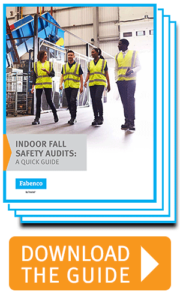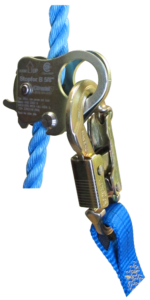
To ensure the safety for workers around the country, OSHA is always looking for ways to improve and clarify safety regulations in response to new information, questions, methodology, and technology. With that in mind, they have recently updated some rules, many of which relate to general industry fall protection. Here’s a look at the new regulations and what you may need in terms of industrial gates and more to stay compliant with these changes.
![]() Personal Fall Protection Systems
Personal Fall Protection Systems
This update to 1910.140(c)(8) applies to a worker’s fall safety harness and safety lanyard. It says, “The gate strength of snaphooks and carabiners must be capable of withstanding a minimum load of 3,600 pounds (16 kN) without the gate separating from the nose of the snaphook or carabiner body by more than 0.125 inches (3.175 mm).”
Previously, the requirement was that snaphooks and carabiners be proof tested to that weight in all directions. Proof testing, however, can damage the equipment, and the standard was never meant to encourage doing so. This adjustment is keeping in line with the original intention of the standard, and it makes the regulation consistent with ANSI standards.
Ladders
The clarification to standard 1910.23(d)(4) is, “The side rails of through or sidestep ladders extend at least 42 inches (1.1 m) above the top of the access level or landing platform served by the ladder.” Previously, 42 inches could have been misconstrued as the exact height required for these rails, when in fact it was intended as a minimum measurement. Taller rails are permitted and may, in some cases, be advisable.
Stairways
Standard 1910.25 “…covers all stairways (including standard, spiral, ship, and alternating tread-type stairs), except for articulated stairs (stairs that change pitch due to change in height at the point of attachment) such as those serving floating roof tanks, stairs on scaffolds, stairs designed into machines or equipment, and stairs on self-propelled motorized equipment.”
Before this update, it appeared that OSHA required all articulated stairs, except for those serving floating roof tanks, to meet the standard. In fact, OSHA never intended any articulated stairs to be included in this requirement, and the new verbiage explains that much better. Safety measures must be taken with articulated stairs, of course, but they are not held to the regulations governing standard stairways, no matter where they are used.
Other Changes
Some of the updates were smaller typographical corrections. That includes an additional update to the stairways standard to include the proper titling of a figure, which had been mistakenly left out. In 1910.27, which covers scaffolds and rope descent systems, the metric equivalent of 5,000 pounds was listed as 268 kilograms when, in fact, it is 2,268 kilograms. In 1910.29, one of the figures was previously mislabeled and has been corrected. In section 1910.269(h)(2), there were some incorrect references to other standards that have been fixed.
If there is something in an OSHA standard that needs clarification, or if you spot an obvious error (such as the metric equivalency example), you can always reach out to OSHA for help. In some cases, your concern may justify a new update to the standards. In other cases, they will simply help you understand what you need to do for your employees. The regulations aren’t in place to “catch” employers who screw up. They’re designed to keep people safe. In a perfect world, OSHA would never need to cite a violation. By asking questions, you’re demonstrating to your employees and management team that you’re seeking to understand so you can keep their safety at the forefront of what you do.
Stay Compliant with Industrial Gates and Other Safety Equipment

OSHA records include a lengthy list of accidents occurring on stairways, indicating there’s a lot of work to be done when it comes to fall protection on stairs. In addition to required handrails along the stairs, using a swing gate at the top is one simple way to protect against accidental falls. If you’re using industrial gates, make sure that “when a door or a gate opens directly on a stairway, a platform is provided, and the swing of the door or gate does not reduce the platform’s effective usable depth to…Less than 22 inches (56 cm) for platforms installed on or after January 17, 2017.” For platforms installed before that date, the effective usable depth should not be less than 20 inches.
It’s also important to note that any types of stairs that are not considered standard should only be used when installing standard stairs is not possible.
A swing gate can also be used to control access to the stairs at the bottom. You could require access credentials, but even if you don’t, industrial gates can remind workers to steer clear unless they require access for the job they’re doing. It also discourages the unintentional placement of objects on the stairs that could present a tripping hazard.
More than likely, in this particular case, the fall safety harness and safety lanyard you’ve chosen for your workers already meets the updated requirements if it met the previous version of the standard. Still, check your equipment, particularly if you purchased it a long time ago or if you worked with a supplier who doesn’t guarantee compliance for the equipment itself.
OSHA compliance comes in two broad forms: the safety equipment you choose and how you use it along with other safety protocols. Though what happens on your worksite is up to you and the culture of safety you’ve created for your employees, you don’t have to guess about the equipment itself. Work with a company that specializes in OSHA-complaint industrial gates and other safety equipment.





